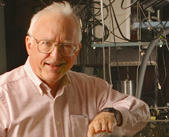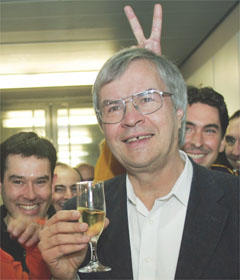Physics Nobel 2005
 Roy J. Glauber
Roy J. GlauberThe Nobel Prize for Physics was awarded to U.S.
scientists Roy J. Glauber and John L. Hall and to
Theodor W. Haensch of Germany for their work
in the field of optics, it was announced Tuesday
in Stockholm. Glauber, 80, of Harvard University
was awarded half the prize money of 10 million
kronor (EUR 1.1 million) "for his contribution to
the quantum theory of optical coherence," the
Royal Swedish Academy of Sciences said.
Glauber's groundbreaking work, reported back in 1963, is in the theoretical
description of the behaviour of light particles. His contributions were
described as "pioneering work in applying quantum physics to optical
phenomena," the Academy said. It added that Glauber had helped explain
"fundamental differences between hot sources of light such as light bulbs,
with a mixture of frequencies and phases, and lasers which give a specific
frequency and phase". Possible implementations of his work on quantum
phenomena include encryption of messages within communication technology.
 John L. Hall
John L. HallHall, 71, of Colorado University and Haensch, 63,
of the Max Planck Institute for Quantum Optics
and Munich's Ludwig Maximilian University, share
the other half of the prize "for their contributions
to the development of laser-based precision
spectroscopy, including the optical frequency comb
technique".
Hall and Haensch's work was on the determination
of the color of the light of atoms and molecules with extreme precision. The
Royal Swedish Academy of Sciences said Hall and Haensch had "made it
possible to measure frequencies with an accuracy of fifteen digits". This could
enable the development of extremely accurate clocks and improved satellite-
based navigation systems (GPS), as well as the study of the constants of nature
over time.

Theodor W. Haensch
Three Cheers!!!
Labels: Laser 1, Nobel Prize, Precision Measurement

0 Comments:
Post a Comment